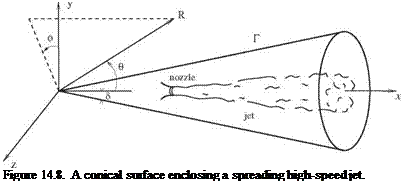Adjoint Green’s Function for a Conical Surface
The noise of high-speed jets is an important aeroacoustic problem. Because the mixing of the jet and ambient gases, the jet expands laterally in the downstream direction. The use of a cylindrical surface Г for this type of flows would not be appropriate. A conical surface with a well-chosen half-angle 5 is a good choice. Figure 14.8 shows a conical surface Г enclosing a high-speed spreading jet. The natural coordinates to use outside the conical surface is the spherical polar coordinates (R,0,Ф).
Let p(g)(R,0,ф, t; R0^0, t0) be the direct surface Green’s function with the source point located at (R0, ф0) and source time t0. The Fourier transform of time t is
![]()
![]()
![]()

![]() (14.60)
(14.60)
The far-field sound pressure due to a surface pressure distribution of Ф (R0, ф0, t0) on the conical surface is then given by
p(R, 0, ф, t) =
to 2n to to
 //// pig)(R, 0, ф; R0, ф0; o; Ц)Ф^0, ф0, t0)e
//// pig)(R, 0, ф; R0, ф0; o; Ц)Ф^0, ф0, t0)e
—TO 0 0 —TO
 |
The surface element of a conical surface is dS = R sin SdRd(p. By the reciprocity relation of Eq. (14.52), p(g) is related to the adjoint Green’s function v’f’1 by
p®(R1> $1, ф1; R0, ф0; t0) = v^ (R0, ф0; R1, в1, ф1; to), (14.62)
where v(n) is the adjoint velocity component normal to the conical surface Г. Positive is in the outward pointing direction.
As for the case of a cylindrical surface, a particular solution of the adjoint equations is given by Eq. (14.55). The relationship between cylindrical coordinates and spherical coordinates is
r = R sin в, x = R cos в.
On replacing r and x by this relation and upon using Eq. (14.55), the particular solution (denoted by a subscript “p”) may be written as
СО / ч
p(a) = -2 Д (R1-R cos в cos e1 Jm 2R sin в sin в1 e-im 2 +іт(ф1-ф).
Pp 8n2fl0R1 m=—О ma0 V
(14.63)
The adjoint velocity is related to the pressure by Eq. (14.49). Thus, the component normal to and on the conical surface is
Now, let the homogeneous solution (denoted by a subscript “h”) of Eq. (14.49) and (14.50) in cylindrical coordinates to have the following form:
This is a Fourier series expansion in angular variable (ф — ф1). The governing equations for the amplitude functions (u(m, vJ, wJ, pm ) can readily be found by substituting Eq. (14.65) into Eqs. (14.49) and (14.50) with the nonhomogeneous term omitted. These equations are as follows:
|
• ‘• (a) 29pm n mum a0 =0 d x |
(14.66) |
|
|
■ Ha) 29pm n i0JVm a0 d r = 0 |
(14.67) |
|
|
— i^w> m + ial = 0 |
(14.68) |
|
|
d v(a) v(a) m л(а) dvm vm. .m ~ (a) ію pm « + i w(m d r r r m |
d u(a) °um 0 dx ’ |
(14.69) |
|
—i – ю R cos 5 cos 0 |
The boundary condition from Eq. (14.51) is
 0 = 5, pm = – Jm[ —R sin 5 sin 01 ) e
0 = 5, pm = – Jm[ —R sin 5 sin 01 ) e
a0
For future reference, it is easy to show that by taking the complex conjugate of Eq. (14.66) to Eq. (14.70) that
u—m (r, x; 01, —ю) = am* (r, x; 01, ю) (14.71)
v(—m (r, x; 01, —ю) = v(m’ (r, x; 01, ю), (14.72)
where * denotes the complex conjugate.
Once u(m) and v(m) are found, it is straightforward to find, by combining with particular solution Eq. (14.64), that the normal velocity of the adjoint Green’s function on conical surface 0 = 5 with (R, ф) replacing by (R0, 00) is
mm (R0, ф0; R1, 01, ф1; ^0,ы)
![]() . I UJ
. I UJ
+ i cos 01 sin 5Jm I —R0 sin 01 sin 5
a0
— i [v(m)(R0, 5; ю) cos 5 — , 5; ю) sin 5]} ■ e—imп +т(ф1— ф0). (14.73)
![]()
By means of the reciprocity relation (14.62), the pressure associated with the direct Green’s function is now known, i. e.,
For later application, it is useful to expand p(g) as a Fourier series in (ф — ф0) in the following form:
Figure 14.9. An oblique Cartesian coordinate system for computing the homogeneous adjoint Green’s function.
![]()

By means of Eqs. (14.74) and (14.73), it is easy to find that
![]() + i cos в sin SJm sin в sin SR0 e a" 0
+ i cos в sin SJm sin в sin SR0 e a" 0
a0
![]() v-)(R0S, o) cos S – ui‘ma)(R0tS, o) sin sJJ. (14.76)
v-)(R0S, o) cos S – ui‘ma)(R0tS, o) sin sJJ. (14.76)
% R
Note: The dependence of pm on R is in the factor. An important property of pm (R, в; R0, o) is that it becomes its complex conjugate if m ^ -m and о ^ – o, i. e.,
![]() p-m (Яв; R0> -0) = Pm (R^; R0,o>.
p-m (Яв; R0> -0) = Pm (R^; R0,o>.











